14 results
Basic principles Common Core MP5 resources

Guide to graphs: Pie charts, bar graphs, line graphs, scatterplots + activities
This is a fantastic resource for introducing students to graphing and data representation. This booklet will take students through the uses for particular graphs and how to construct them. At the end of each module, there are activities for students to complete, to practice their graphing skills. Answer key is included, making this a no-prep activity. This booklet covers: - why we visually represent data- pie charts and how to create them - bar graphs and how to create them - line graphs and how
Subjects:
Grades:
6th - 12th, Higher Education, Adult Education
Types:
CCSS:

Balanced & Unbalanced Forces NGSS 3-PS2-1 Science Differentiated Reading Passage
⭐️Science differentiated reading passages about balanced and unbalanced forces for a forces in motion unit. Students will read articles to build background knowledge about the effects of balanced and unbalanced forces on the motion of an object. ⭐️Students will read articles about Newton's Laws of Motion, and real life scenarios that have balanced and unbalanced forces such as crash test dummies, playing golf, or building a house of cards. ⭐️ This unit is perfect for 3rd grade. It was created to
Subjects:
Grades:
3rd
Types:
NGSS:
3-PS2-1
Also included in: 3rd Grade NGSS Differentiated Science Passages Bundle
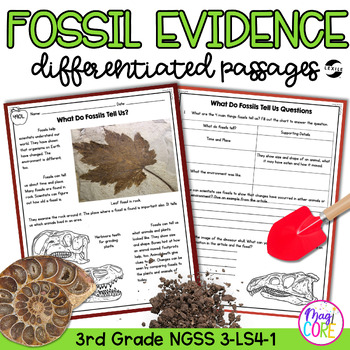
NGSS Differentiated Passages: Fossil Evidence of Past Environments - 3-LS4-1
⭐️ These science differentiated passages focus on analyzing and interpreting data from fossils to provide evidence of the organisms and the environments in which they lived long ago. Examples of data could include the type, size, and distribution of fossil organisms. Examples of fossils and environments could include marine fossils found on dry land, tropical plant fossils found in Arctic areas, and fossils of extinct organisms. Assessment does not include the identification of specific fossils
Subjects:
Grades:
3rd
Types:
NGSS:
3-LS4-1
Also included in: Ecosystem Change NGSS Science Differentiated Passages BUNDLE - 3rd Grade

Weathering and Erosion NGSS 4-ESS2-1 - Science Differentiated Passages
⭐️These science differentiated passages focus on making observations and/or measurements to provide evidence of the effects of weathering or the rate of erosion by water, ice, wind, or vegetation.⭐️This unit is perfect for 4th grade. It was created to align with 4-ESS2-1 but can be used in any classroom to teach students about weathering and erosion.⭐️Integrates key reading skills, with a focus on drawing conclusions and making inferences. Incorporates key vocabulary, text features, graphic orga
Subjects:
Grades:
4th
Types:
NGSS:
4-ESS2-1
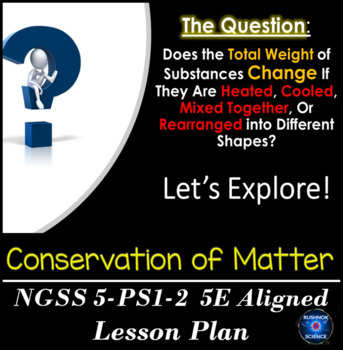
NGSS 5-PS1-2 CONSERVATION OF MATTER ALIGNED 5E LESSON PLAN
NGSS 5-PS1-2 Conservation of Matter Aligned 5E Lesson Plan is designed to take students on an engaging journey starting with movie scenes from the Wizard of Oz. Students view a movie clip and are asked to identify gases, solids, and liquids they see. The students are then asked the most important question for NGSS 5-PS1-2: Does the total weight of substances change if they are heated, cooled, mixed together, or rearranged into different shapes? . The students are then asked to explore the
Subjects:
Grades:
4th - 7th
NGSS:
5-PS1-2
Also included in: NGSS Fifth Grade Science Curriculum Bundle | Phenomena-Based Lessons!

Weather Seasons NGSS 3-ESS2-1 Science Differentiated Passages
⭐️ In these science differentiated passages students will study and create data in tables and graphical displays to describe typical weather conditions expected during a particular season. Other Standards To Address in Questions and Images3.MD.A.2 - Measure and estimate liquid volumes and masses of objects using standard units of grams (g), kilograms (kg), and liters (l). Add, subtract, multiply, or divide to solve one-step word problems involving masses or volumes that are given in the same uni
Subjects:
Grades:
3rd
Types:
NGSS:
3-ESS2-1
Also included in: 3rd Grade NGSS Differentiated Science Passages Bundle
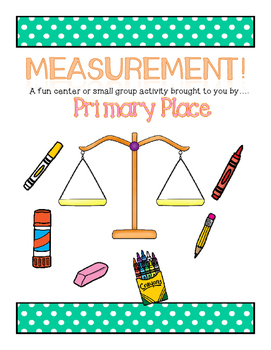
Measurement Center- Using a Classroom Balance!
This product is intended to be used with a classroom balance. A balance is a scale that you can use by putting something you would like to measure on one side, and then using items on the other side to “balance” the scale. For example, if I want to know how many pennies heavy a box of crayons is, I can put the box of crayons on one side of the balance, and keep adding pennies to the other side until the scale is perfectly balanced!
This would be a great activity to do during a math center f
Subjects:
Grades:
K - 3rd
Types:
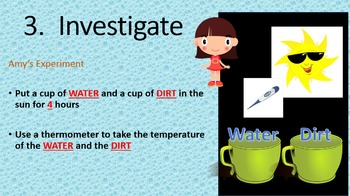
Next Gen Science: Plants, Water, Light, and the Scientific Method
Captivate your students with interactive videos, sing-a-longs, interactive Power Point presentations, and hands-on science lab as students use the scientific method to prove whether plants needs water and light.
Students will love the hand motions to help them remember the scientific method!
Students will look forward to using their data collections charts as they observe how their plants are surviving (or not) given the conditions of the experiment.
You’ll have your students singing the
Subjects:
Grades:
2nd
Types:
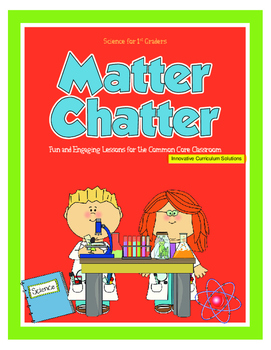
Matter Chatter: Common Core Science for First Graders (50+ Pages)
This unit focuses on matter. It is intended for first graders, but could be adapted to fit kindergarten through grade three.
It contains:
10 Lesson Plans
2 Vocabulary Quizzes
1 Unit Plan
1 Glossary
1 Pretest
1 Final Exam
Answer Keys for tests and quizzes
Vocabulary includes:
Matter
Weight
Mass
Gravity
Scale
Balance
Square
Rectangle
Perimeter
Length
Width
Five Senses
Properties
Classification
The first lesson plan can be DOWNLOADED for FREE:
What’s the Matter: Teaching Science to First Grader
Grades:
K - 3rd
Types:
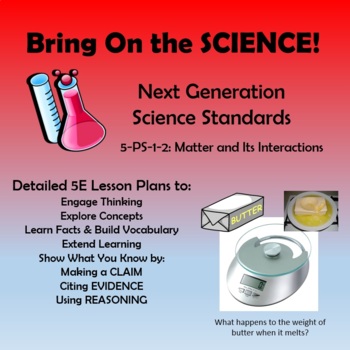
Bring On the Science! (5-PS1-2) Complete Lessons and Activities
Guide students through the complex world of science with this easy-to-use, teacher- and student-friendly resource. This lesson targets NGSS 5-PS1-2: Matter and Its Interactions. Included are all the pieces for you and your students, including investigations, informational text, vocabulary activities, extension activities, and evaluation options.
Subjects:
Grades:
4th - 6th
Types:
NGSS:
5-PS1-2
Also included in: Bring On the Science! 5-PS1-1 and 5-PS1-2 BUNDLE!

Place Value Charts
Welcome to Tuscarora Teacher Reaching for the Stars!Place Value ChartsPlace Value Charts show how standard form numbers are written in groups of three, which are called periods. Building number sense by understanding place values is an important math skill. These charts can be the ticket for easy and repeated reference if posted in your classroom the whole year. Students will be able to read numbers correctly as well as build numbers.Features:15 ChartsGrouped in Periods Decimals to Duodecillions
Subjects:
Grades:
3rd - 8th
Also included in: Math Must Haves BUNDLE

Bring On the Science! 5-PS1-2 Student Materials Only
This is an abbreviated version of the complete lessons, offering just student-facing materials. These activity pages target NGSS 5-PS1-2: Matter and Its Interactions. Included are investigations, informational text, vocabulary activities, extension activities, and assessment options.
Subjects:
Grades:
4th - 6th
Types:
NGSS:
5-PS1-2
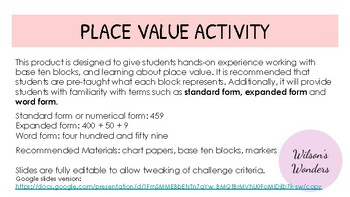
Place Value Robot Activity
This product is designed to give students hands-on experience working with base ten blocks, and learning about place value. Providing an opportunity for group collaboration and teamwork, students will build robots using base ten blocks.
Subjects:
Grades:
2nd - 4th
Types:
Also included in: Number Sense Unit + Place Value Robot Activity!

Data Discovery
Use this activity at the beginning of the school year in Science class to teach and refine data collection skills, build conversations about data analysis, and graphs vs. tables. Students will use classroom items and collect data from their peers to determine how to graph and organize information they have collected. Scientific method, data analysis, or an icebreaker for science.
Subjects:
Grades:
5th - 9th
Types:
CCSS:
NGSS:
MS-ETS1-4
, 3-5-ETS1-2
, MS-ETS1-3
Showing 1-14 of 14 results





